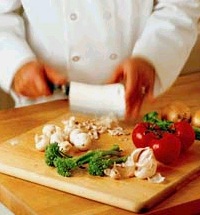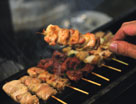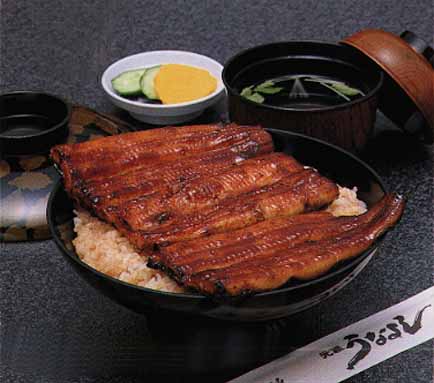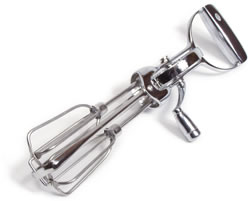|
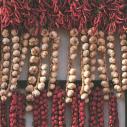
Al Dente
An Italian
term meaning “to the tooth.” It refers to the firm but tender consistency a
perfectly (in some opinions) cooked piece of pasta should have.
A la
(French) The
style of, such as: a la Francaise (The style of the French).
A la
Bourgeoise
(French) The
style of the family (family style).
A la
Broche
(French)
Cooked on a skewer over a flame. See Brochette.
A la Carte
(French) Each
menu item is priced separately: Foods prepared to order.
A la King
(French) A
Béchamel sauce containing mushrooms, green peppers, and red peppers or pimentos.
A la Mode
(French)
Refers to ice cream on top of pie.
A la
Florentine
Literally
French for "in the style of Florence". in Italian its "alla Fiorentina". It
refers to dishes served on a bed os spinach and topped with mornay sauce.
A la
Provencale
(French)
Dishes prepared with garlic and olive oil. See Provencale.
A la Russe
(French) The
Russian way.
A.P.
As Purchased.
Arroz A La
Espanola
Spanish rice.
Arroz Con
Pollo
Chicken with
rice.
Au Gratin
(French) To
top food with cheese or bread crumbs, then baked.
Au Jus
(French)
Served with natural juices.
Affriander
(French) To
give a dish a more appetizing appearance by garnishing it.
Affriter
A French term
used to describe the seasoning of a pan. This can be achieved by rubbing it with
salt or by heating a little bit of oil in the pan and then drying it with a
cloth.
Alabaster
A shaker dish
of mashed potatoes and turnips, name after the silvery white colour.
Amandine
(French)
Prepared with or garnished with almonds.
Aging
A term used
to describe the holding of meats at a temperature of 34 to 36 degrees F. for a
period of time to break down the tough connective tissues through the action of
enzymes thus increasing tenderness.
Accolade
En accolade
means presenting two similar kinds of food leaning on each other on the same
plate. The term usually applies to poultry and game hens.
Acidulate
To give a
dish or liquid a slightly acidic, tart or piquant taste by adding some lemon
juice, vinegar, or unripened fruit juice. Also, one can acidulate fresh cream by
adding lemon juice to get sour cream
Abaisse
A French term
for a sheet of rolled out pastry which is usually used as base in a dessert. It
can also mean a cookie or slice of sponge cake on which a filling (preserves or
cream) is to be spread.
Aboukir
Almonds
A
sugar-glazed petit-four made by pressing two whole blanched and roasted almonds
into the sides of a ball of green-colored marzipan. It is then held with a
dipping fork and dipped into boiled sugar syrup and left to sit on parchment
paper until firmly set.
B
Bruschetta
Originally
from the Italian "bruscare" meaning "to roast over coals," It is traditionally
made by rubbing slices of toasted bread with garlic cloves, then drizzling the
bread with extra-virgin olive oil. The bread is salted and peppered, then heated
and served warm. Most people serve it topped with tomato, garlic, basil.
However, these days restaurants and marketers are calling any piece of dough
with a chopped up topping a "bruschetta".
Bake
Cooking in an
oven.
Baste
To pour
drippings, fat, or stock over food while cooking.
The process
of spooning or pouring pan juices over food while it cooks. This promotes
moistness and a browned surface.
Bard
To wrap meat
with bacon or salt pork
Beat
Making a
mixture smooth by whipping or stirring with a spoon, fork, wire whisk, or
beater.
Blanch
To place
foods in boiling water briefly either to partially cook them or to aid in the
removal of the skin (i.e. nuts, peaches, tomatoes). Blanching also removes the
bitterness from citrus zests
Blanch
Refers to
partially cooking an ingredient, usually vegetables, by placing them in boiling
water for a few minutes.
Blend
Combining
ingredients until smooth and uniform in texture, flavor, and color.
Blind Bake
To bake a pie
crust without the filling. Metal weights or dried beans are usually used to keep
the pastry from bubbling.
Boil
Heating
liquid, which causes a constant production of bubbles that rise and break the
surface.
Bombe
A frozen
dessert made by lining a special mold with ice cream or sorbet, The center
cavity is then filled with a mousse, cream or parfait mixture. The mold is
tightly sealed and the dessert is frozen solid before unmolding and serving.
Braising
A cooking
method where food (usually meat) is first browned in oil, then cooked slowly in
a liquid (wine, stock, or water).Cooking food slowly in a small amount of liquid
in a tightly covered pan.
Broil
Cooking food
using an overhead source of heat.
C
Calorie
Unit of heat;
1 calorie = 3.968 B.T.U. The heat required to raise 1 gram of water 1 degrees
centigrade.
Canape
(French) An
appetizer prepared on a base such as toast or crackers.
Candy
Thermometer
Usually a
large glass mercury thermometer that measures temperatures from about 40 degrees
F to 400 degrees F. A frame or clip allows it to stand or hang in a pan during
cooking.
Carmelize
The process
of causing sugar or the natural sugars in food to darken to a golden brown and
develop a rich flavor by cooking on a constant heat.
Capirotada
(Bread
Pudding) Toasted bread topped with caramelized-sugar corn syrup, sliced longhorn
cheese, raisins and cinnamon, and baked until cheese melts.
Chaud
(French) Hot.
Chop
Cutting foods
with a knife into smaller pieces.
Clamart, a
la
Any of a few
dishes that include green peas (either whole or in a puree). Its named after a
district of Hauts-de-Seine that was famous forits pea crops. Famous Clamart
dishes include Clamart soup (puree of fresh peas in consomme), poached eggs
Clamart, and puff pastry Clamart. There is also a garnish called Clamart
(tartlets or artichoke bottoms filled with buttered peas).
Cream
Beating
butter or shortening, either alone or with sugar, until it is light and fluffy.
Crepe
(French) Thin
pancakes.
Cut In
Working a
solid fat such as butter or shortening into dry ingredients.
Dash
1/16 teaspoon
measure. (Use 1/2 of a 1/8 teaspoon measure.)
Deglaze
To add liquid
such as wine, stock, or water to the bottom of a pan to dissolve the caramelized
drippings so that they may be added to a sauce, for added flavour When the
liquid is added, it loosens the flavour from the pan to make a sauce for the
meat.
Devil
To combine a
food with various hot or spicy seasonings such as red pepper, mustard or a
piquant spicy sauce, thereby creating a "deviled" dish. Devilled dishes are very
popular in English cookery; devilled eggs being one of the most popular.
Diable
Devilled.
Dice
To cut up in
uniform pieces. Cut into small cubes.
Usually in
1/8 to 1/4 inch squares.
Dissolve
Stirring a
solid food into a liquid to form a mixture in which the solid food does not
remain.
Doria, a
la
The name
given to various dishes dedicated to the famous Genoese Doria family. The dishes
evoke an Italian image in one way or another; for example, combining green,
white, or red colors (the colors of the Italian flag) or by including
Piedmontese truffles. Famous a la Doria dishes include bombe Doria, chicken
Doria, and Doria salad.
Double
Boiler
Like a
bain-marie, a double broiler is a method of cooking without using direct heat.
It usually consists of two saucepans that fit together. The bottom sauce pan is
filled with water and the top one with the mixture (custard, chocolate, etc.).
The saucepans can be made from stainless steel, aluminum, and glass.
Dredge
Coating food
with flour, corn meal or sugar before of after cooking.
Dredging
To coat with dry ingredients such as
flour or bread crumbs.
Dusting
To sprinkle with sugar or flour.
E
Emulsion
Suspension of
two liquid ingredients that do not dissolve into each other.
E.P.
Edible
Portion
F
Fold
A method of
gently mixing ingredients. Use a rubber spatula to cut down through the mixture,
move across the bottom of the bowl, and come back up, folding some of the
mixture from the bottom close to the surface.
Fry
Fast browning
and cooking food in varying amounts of fat, most often at a high heat.
Farce
(French) Forcemeat or Stuffing.
Farci
Stuffed.
G
Garde
Manger
(French) The
person in charge of cold meat department or the department itself.
Garnish
Adding extra
appeal to a finished dish. To decorate. Also referring to the food used to
decorate.
Garniture
French for
garnish.
Grate
Using a
grater to rub food, such as vegetables, cheeses and spices, across surface to
make fine pieces.
Gratin
Any sweet or
savory dish baked or broiled so its topping forms a golden crust.
Juice
Extracted
liquid that comes from fruits, vegetables or meats.
Julienne
Cutting food
into thin sticks about two inches long.
Kitchen
Bouquet
A trade name
a bottled sauce flavour and colour enhancer
Marinade
A process of
flavouring food by soaking in a liquid or dry mixture.
Macerate
To soak a
fruit in liquor or wine. This softens the fruit while releasing its juices and
absorbing the macerating liquid's flavour.
Mash
Removing all
lumps from food with either a fork or electric beater.
Melt
To heat a
solid food until it becomes liquid or semi-liquid.
Mix
Beating or
stirring foods together until they are incorporated.
Maitre
d'Hotel
(French) The
head of the catering department.
Maitre
d'Hotel, a la
(French) A
yellow butter sauce consisting of lemon juice, parsley, salt, pepper, and drawn
butter. Butter: Same as theother but with whole butter.
P
Pit
Taking the
seed out of a piece of fruit or vegetable.
Pizzelles
Thin
decoratively patterned Italian wafer cookies that are made in an iron similar to
a waffle iron. They may be flat or rolled into ice cream cones.
Poach
Cooking food
by placing in simmering liquid.
Posole
Hominy stew
made with dried lime-treated corn and combined with pork and seasonings.
Primavera
Primavera
literally means "spring style” in Italian. This usually means topping a dish
with fresh vegetables (raw or blanched). Pasta Primavera is one of the most
common primavera dishes and usually has a combination of the following:
broccoli, squash, asparagus, red bell peppers, and peas. Just on its own pasta
with fresh vegetables might be too bland, so many cooks supplement the dish with
either a light, broth based sauce or a creamy cheese sauce.
Princess,
a la
Any dish
(usually poultry, salmon, sweetbreads, or egg) topped with the rich garnish of
asparagus tips and slivers of truffle.
Proscuitto
The Italian
word for ham, used in the names of raw hams coming from Italy, in particular
Proscuitto di Parma and Proscuitto di San Daniele
Proof
Allowing a
yeast dough to rise before baking.
Pre-heat
Heating the
oven to the temperature needed before using it.
Puree
Blending a
food into a liquid or heavy paste.
Reconstitute
Bringing
condensed or concentrated food to its original strength by adding water.
Reduce
Briskly boil
liquids, so that the liquid evaporates to thicken the sauce making it rich and
flavourful.
Roast
Cooking an
uncovered piece of meat in an oven.
Ragout
A stew made
from poultry, game, fish, or vegetables cut into pieces and cooked-with or
without first having been browned- in a thickened liquid, generally flavoured
with herbs and seasonings. There are two basic types of ragout: brown and white.
For a brown ragout, the meat is first browned in fat, then sprinkled with flour,
cooked a little, and finally moistened with clear stock or water (or thickened
meat juices, if the meat has not been floured). For a white ragout, , the meat
is cooked until firm, but not coloured, then sprinkled with flour and diluted
with stock.
Roasting,
Peeling, and Seeding a Bell Pepper
Many methods
exist for roasting peppers. Among them are roasting them atop a stove, in an
oven broiler, on a grill, and in hot oil. Using the broiler to roast peppers is
my preferred method. I find it the least messy and lends itself to preparing
large quantities. It is also the only one I have enough experience to explain in
detail. Roasting: Preheat the oven broiler for 15 minutes. Place the peppers on
the top rack (3-4 inches away from flame). Once a side has blackened., turn
(with tongs, fork, towel, or other utensil). Repeat until all sides are
blackened. If you are using this method for chili pepper, other than the bell
pepper, you have to monitor closely so as only the skin and not the flesh of the
pepper is charred. The bell pepper has a hardier skin and does not burn so
easily. Peeling: Two different methods can be employed to peel a charred pepper.
I personally prefer the first method. Place the peppers in a plastic or paper
bag. Fold over the top of the bag, so no steam can escape. This way the steam
will build up between the flesh and the skin, making peeling even easier. When
the pepper is cool enough to handle (20 minutes), take out of the bag and peel
the rest by hand. OR Submerge the charred pepper into a bowl of ice cold water.
This will stop the cooking process and aid in the removal of the skin. Once the
pepper is cool enough to handle, peel off the rest of the skin. Seeding: If you
are going to be using the peppers whole, make a slit down one side, leaving a
small space at both ends. Carefully remove the inside with a knife, small spoon,
or one of those otherwise useless melon ballers. Otherwise, just remove the
stem, remove the seeds and veins with your fingers, and rinse the pepper under
water. Sometimes, I seed the pepper before it is charred, with no real
difference in the final result.
Sauté
Cooking on a
stove in a small amount of oil or butter until tender.
Score
To cut slits
through the outer surface of food before cooking to tenderize or to make a
decorative pattern.
Sear
Quickly
browning meat on all sides with high heat to seal in the juices.
Shred
Making long
narrow strips of food with a food processor or a grater.
Sift
Putting dry
ingredients such as flour or sugar through a sifter or mesh screen to loosen
particles and incorporate air.
Simmer
A method of
cooking food in liquid that is kept just below the boiling point.
Sorbet
A smooth
frozen ice made with flavoured liquids, either sweet or savoury. Unlike sherbet,
it never contains dairy products.
Skim
Removing any
fat or foam from the surface of liquid.
Steam
A method of
cooking food in the vapour given off by boiling water.
Steep
Letting a
food, such as tea, stand in water that is just below boiling to extract flavour
and color.
Stir
Incorporating
ingredients with a spoon to prevent them from sticking during cooking or to cool
them after cooking.
Spaetzle
A dish of
small noodles or dumplings made with flour, eggs, water or milk, salt and
sometimes nutmeg. In German, spaetzle literally translates to "little sparrow"
and is typically served as a side dish like potatoes and is often accompanied by
a sauce or gravy.
Spatchcocking
A French
technique of butterflying a whole chicken by removing the backbone so you can
open it up flat, like a book, and cook it using direct heat. Because the
spatchcocked chicken cooks over fiery hot coals, the process cuts the grilling
time almost in half and helps keep the meat moist.
Sundae
A dessert of
ice cream served with one or more toppings, such as flavored syrup, dessert
sauce, nut, whipped cream, fruit, etc. It is said to have originated in
Massachusetts when a law prohibiting the sale of all soft beverages on Sunday
was passed. An enterprising soda jerk combined ingredients of an ice cream soda
but omitted the carbonated beverage to make a 'sundae'.
Toast
Heating nuts,
seeds, coconut or bread in the oven until they are slightly browned. This will
bring out their natural flavour.
Toasting
Nuts
Toasting nuts
brings the oils closer to the surface, bringing out the flavour. This is
especially useful in low fat cooking, where you want to use less nuts, since
they tend to be extremely high in fat. Toasting also makes removing the skins
off of nuts easier. Preheat the oven to 350 degrees F. In an ungreased cookie
sheet, spread the nuts in a single layer and let bake for 6 minutes. Remove from
the oven. If you want to remove the skins from nuts, wrap the toasted nuts in a
kitchen towel. Let the nuts steam for 5 minutes. Roll the nuts around (while
still in towel) until skins rub off.
Vichyssoise
A cold potato
and leek soup thickened with cream and garnished with chives. The term is now
applied to many other tuber-based soups.
Vaporize
To turn
liquids into gasses.
Whip
Beating food
rapidly by using a whisk or electric beater to incorporate air into the mixture.
Whisk
A mixing tool designed so its many strands of looped wire
make it effective for beating. To beat with a whisk until well mixed.
Washed
A form of
cleansing food before preparation or eating.
Water bath
Bain
Marie in French. A method of gently cooking delicate foods such as custards, on
the stove or in the oven in a pan partially filled with water.
|



